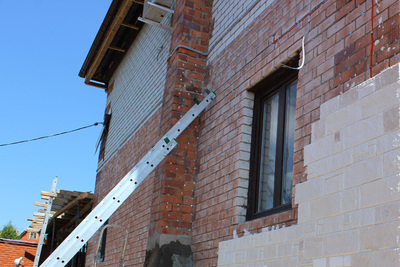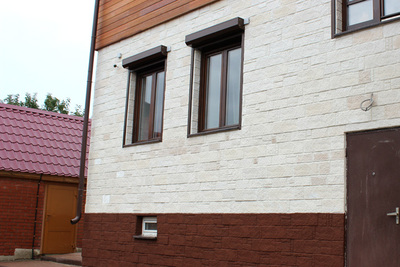Manufactured stone over silicate brick surfaces
Installation of manufactured stone veneer over sand-lime brick surfaces

Times change, as do tastes, styles, fashion and building materials. At the end of the last century, houses made of sand-lime bricks were very common. These houses have successfully stood to our time and have grown very old. They look gray and dull. And who would not want to make his/her house look better? Only the lazy ones wouldn’t!
Art-Stone Company is ready to help you redecorate your house. If you have a house made of sand-lime bricks, that’s not a problem! It can also be faced with manufactured stone siding.
Let us describe the technology of facing sand-lime brick surfaces with stone veneers.
1. Take a team of experienced professionals (experienced not just in word, but in deed).
2. Before facing, the walls need to be primed with facade betokontakt (adhesion primer for facades and walls).
3. A welded galvanized mesh with a 30mm by 30mm cell is welded to the primed wall using dowel-nails. The wall is now ready for cladding.
4. For facing, use a glue for manufactured stone from the Granite series. There are such brands as UNIS, Bergauf, Ceresit and so on.
5. Cladding with manufactured stone veneer should be done at temperatures of at least 5 °C. We recommend pre-applying a thin layer of adhesive to the wall and then applying the adhesive to the stone veneer itself using a comb trowel. After that, press the stone veneer against the wall and make three or four rotational movements clockwise and counter-clockwise. Remove excess glue.
6. If the facing surface is going to be grouted (i.e. have a seam), it is necessary to leave a joint 10-12 mm wide. In order to maintain the joint width constant, have small pieces of plasterboard handy. After the glue dries, prepare the grout and apply it to the joints using a special syringe (or simply a rigid plastic bag after cutting a corner). After half an hour, spread and work the grout into the joints with a shaped metal spatula for grouting. Promptly remove excess grout from the stone veneer with a damp sponge.
7. The revetted surface should be treated with hydrophobic silicone- or acrylic-based coating. Use a brush or a spray gun to apply a hydrophobizator.
Following the above mentioned recommendations, you can turn your house into a nice and cozy home, attractive to look at and hospitable to stay in for years to come.
| Before | After |
 |
 |

